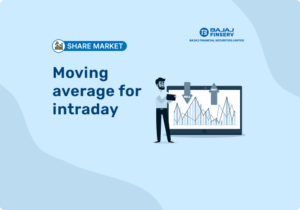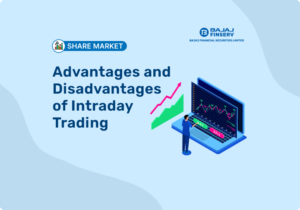How Does Intraday Trading Work?
Last Updated on September 27, 2023 by BFSLTeam BFSLTeam

Among the different trading techniques traders use, intraday trading is one of the most popular. It involves purchasing and selling a security within the same day. One of the highlights of intraday trading is that it requires much less capital due to the use of leverage. Leverage enables you to enter into large positions by simply paying a small fraction of the total trade value as a margin.
Since all open positions are squared off by the end of the day, intraday trading tends to be more fast-paced compared to other trading techniques. Also, it requires a tremendous level of concentration and focus. If you’re interested in intraday trading and are planning to take it up in the future, here’s an overview of how it works.
How Does Intraday Trading Work?
Let’s take a hypothetical example to understand how intraday trading works. Assume you wish to trade in the stock of ABC Limited. Currently, the stock price is at ₹350 per share. Since the company posted stellar financial results for the previous quarter, you expect the share price to rise during the day. To take advantage of this situation, you plan to execute an intraday trade.
Since you’re trading intraday, your stockbroker is willing to offer a 4X leverage, meaning that for every ₹1 you deposit with your broker, your purchasing power increases to ₹4. As soon as the trading session starts, you purchase 100 shares of ABC Limited at ₹352 per share. Now, normally, you would have to invest ₹35,200 to execute the trade. However, since the trade is intraday and you’re eligible for 4X leverage, you only need to invest ₹8,800 to purchase 100 shares of ABC Limited.
Within just a few hours, the share price of ABC Limited rises to ₹365 per share. At this point, you decide to book your profits by selling the 100 shares of the company. This gives you a profit of ₹1,300 (100 shares x ₹13).
Since you bought and sold the shares of ABC Limited within the same trading day, there would be no delivery of the said shares in your demat account.
Intraday Trading – Things You Need To Know
Getting to know the intraday trading basics may not always be enough. Here’s a quick overview of some key things you need to know before you start intraday trading.
- Choosing the Right Security is Crucial
Stocks aren’t the only securities eligible for intraday trading. In fact, commodities, currencies and equity derivative contracts like futures and options are also eligible. However, irrespective of the type of security you choose to trade in, you need to ensure that it is liquid and volatile.
Liquidity is a measure of how easy it is to buy and sell a security. The higher the liquidity, the easier it is to enter and exit positions. Volatility, meanwhile, is the measure of how fast an asset price changes. The higher the volatility, the quicker the price movements are.
A highly-liquid and volatile security is key for intraday trading as it allows you to quickly enter and close positions.
- Requires In-Depth Market Knowledge
Intraday trading requires you to be aware of the demand and supply dynamics of a security and the factors that can influence its price. Economic data, earnings reports, repo rate announcements, government policy changes, trade restrictions and geopolitical scenarios are a few factors that affect the prices of securities. To succeed in intraday trading, it is important to constantly stay up-to-date with such factors and market-moving news and events.
- Knowing the Market Trend is Essential
Being aware of the current market trend is one of the major prerequisites for intraday trading. It can help you determine the kind of position you need to enter into. For instance, if the market is bullish, you can consider entering into a long position. If the market is bearish, you can consider shorting the security. Purchasing or selling a security without knowing what the trend is can lead to bad trading decisions.
- Risk Management is Key
Risk management is a key part of intraday trading basics. A proper and well-defined risk management plan can help you reduce losses if the market moves against your positions. Position sizing and stop loss orders are two crucial risk management practices you could use when trading intraday to mitigate risk. Stop loss orders, especially, can protect your investment capital by preventing you from accumulating huge losses.
- Selecting the Right Time to Trade
Timing is a major aspect of intraday trading. The markets tend to be very volatile at the start of a trading day. You can witness similar levels of volatility, if not higher, near the end of the day as well. The middle phase, meanwhile, tends to be relatively more stable and less volatile.
Therefore, if you’re someone who doesn’t prefer periods of high volatility, you could restrict your intraday trades to the middle phase. On the other hand, if you thrive under high volatility, you could consider trading during the initial and closing phases of a trading day.
- Technical Analysis Can Improve Chances of Success
Technical analysis involves using a set of techniques, indicators and chart patterns to predict the price movement of a security. They can come in very handy when trading intraday. Using the right technical indicators and identifying chart patterns, you can predict how the market will behave, thereby improving your chances of success. However, it is essential to note that technical analysis is a vast concept and requires immense effort and dedication to master.
Conclusion
Now that you know how intraday trading works, you should be confident enough to try this technique. That said, remember to select a security that’s liquid and volatile. As you’ve already seen, high liquidity and volatility are two primary prerequisites for intraday trading.
Furthermore, considering that you’re new to this, it is advisable to start with a small position size. This way, you can limit the risk and losses if the market moves against your expectations. Once you’ve gained enough experience, you can increase your position size gradually.

